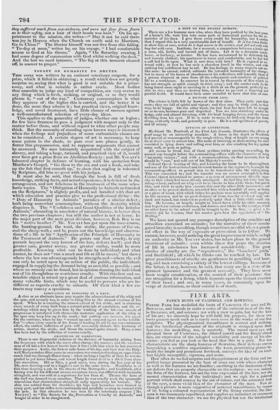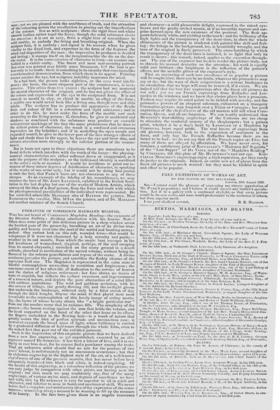FINE ARTS.
PARK'S BUSTS OF CAMPBELL AND BOWRING.
PaTrue PARK has modelled the busts of CAMPBELL the poet and Dr. BOWE [NG, and intends to make a series of the eminent men of the day, in literature, art, and science; not with a view to gain, but for the love of his art : we sincerely hope he will fulfil his purpose, for these two busts possess merit such as is rarely seen even in the works of our first sculptors. The physiognomical resemblance is correct and striking, and the intellectual character of the originals is stamped upon their features ; flue modelling, too, is masterly. The rennet open eye and elevated brow of CA]mPBELI„ the dilated nostril and the firmly-closed lips, are expressive of the mingled sensibility and energy of his cha- racter: you feel as you look at the head that this is a poet. Not less characteristic are the sharp features of Downiso, their delicate carves bespeaking a sensitive organization : the keen, penetrating glance be- neath the ample and prominent forehead, conveys the idea of an intel- lect highly susceptible, vigorous, and acute. How often do we feel surprise and disappointment at the faint and im- perfect image presented by the bust of some one with whose character as well as his features we are familiar ; ascribing to the limitation of the art defects that are properly chargeable on the sculptor : we see, indeed, the form of the features, but not the true expression of the face, nor the mental characteristics of the individual ; and we sigh for a painted portrait which shall convey by the aid of colour, and the animated look of the eyes, a more vivid idea of the character of the man. Now al- though a picture is more suggestive of personal resemblance, by reason of its being a coloured representation of the living exterior, the like- ness is too commonly superficial, and supplies an indistinct or erroneous idea of the true character : we see the physical but not the intellectual inse ; yet we are pleased with the semblance of truth, and the attraction of the colouring assists the recollection in piecing out the imperfections of the painter. Not so with sculpture : there the rigid lines and white smooth surface rather repel the fancy, though the solid substance rivets the attention : it is not so easy, from a slight hint of resemblance in cold marble, to embody the living and breathing original. When the sculptor fails, it is entirely ; and signal is his success when he gives vitality to the fixed look, and expresses in the form of the features the mind and disposition of the man : the impression he produces is decided and lasting ; it stumps itself on the imagination like the die on the duc- tile metal. It is the concentration of character in form—an essence em- bodied in a visible entity. The finest and most real-seeming portrait that ever was painted may falsify some lineament, b'f the bust is
po- tent only in its truth : there is something in its identity that convinces like a mathematical demonstration, from which there is no appeal. Painting sooner catches the eye, but sculpture indelibly impresses the mind.
In a bad bust, the person looks sightless, or the eyes want intelli- gence ; the brow, the most eloquent part of the countenance, is inex- pressive. This arises from two causes : the sculptor had not mastered the mental character of the original, and lie has not given the effect of the colour and expression of the eye in the sculptural form. It is not enough to mould in clay, or chisel in marble an effigy of the form ; a marble eye would never look like a living one, though nose and chin might. The sculptor has to produce the appearance of the flexile form and colour of life in a colourless and rigid substance ; and in order to do this, he must make the form of the marble cast such answering to the living person : if, therefore, he give to accidental and shadows as combined with the substance may produce an ensemble unimportant markings of the thee the same prominence that he does to the salient points of character, the result is a confused and erroneous impression on the beholder ; and if in modelling the open mouth and expanded nostril, he give to the lower part of the thee stronger effects of light and shade than to the upper, be leaves the eye and brow dim, and attracts attention more strongly to the inferior portion of the counte- nance.
But in busts not open to these objections there are sometimes to be found defects which interfere with the truth of the image : the physiog- nomical characteristics are either softened down or exaggerated, as it suits the purpose of the sculptor ; or the indivkaud identity is sacrificed to the artist's style or manner. It would be invidious to point out in- stances of these minor degrees of fidsification of character, in speaking of the works of one artist only, but it would not be doing him justice to omit the fact, that Pane's busts are not obnoxious to any of these charges. As an example of the fidelity of his resemblances, we may instance the bust of Mr. JOIIN LAN oseen, exhibited in the British Insti- tution in the last display but one of the works of Modern Artists, which conveyed the idea of a deaf person, front the force and truth with which the physio„emomical peculiarities of the individual were represented. He has modelled admirable likenesses also of flaybox the painter, Miss ItAmmern the vocalist, Mrs. APIAN the painter, and of 1)r. MAceLoo and another minister of the Scotch Church.



























 Previous page
Previous page